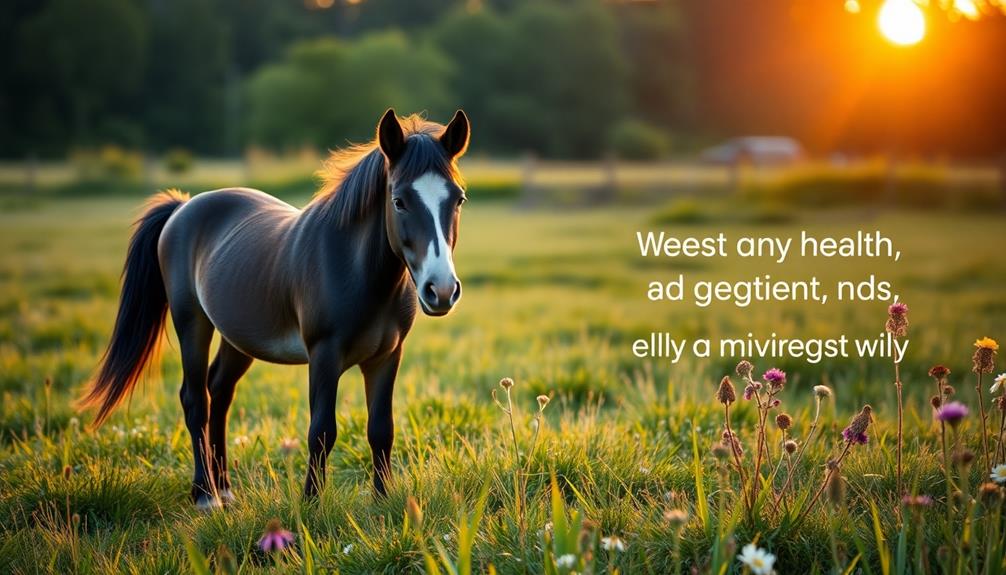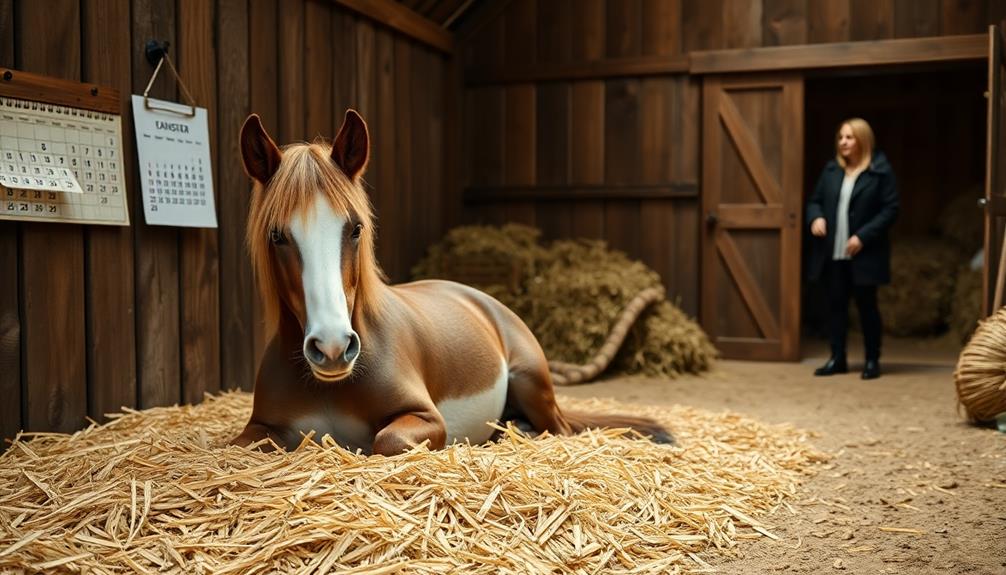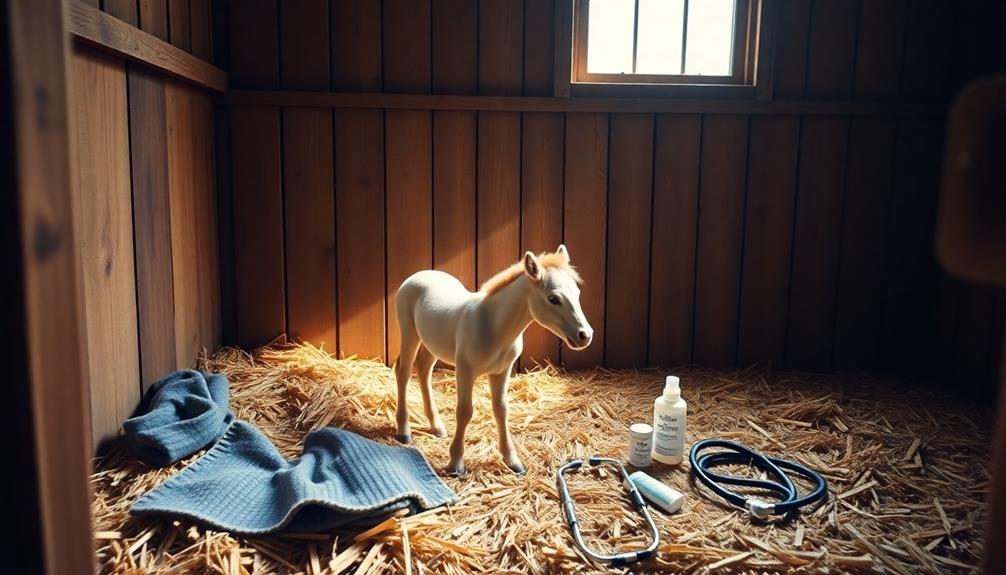Your miniature horse usually stays pregnant for about 11 months, with gestation lasting between 320 to 380 days. The average is around 330 days but can vary based on several factors, like the mare's age, health, and even the stallion's genetics. Sometimes, foals can be viable if born as early as 290 days, but this isn't common. As your mare approaches her due date, you'll notice physical and behavioral changes indicating imminent foaling. Staying informed will help you prepare for their arrival and guarantee a smooth process. You can discover more about foaling preparations and care.
Key Takeaways
- Miniature mares typically have a gestation period of about 11 months, averaging around 330 days.
- Gestation can range from 320 to 380 days, with viable foals born as early as 290 days.
- Factors like the mare's age, stallion genetics, and seasonal changes can influence gestation length.
- Close monitoring of udder development and behavioral changes is essential in the final weeks before foaling.
- Start observing mares for signs of imminent foaling around day 280 of their gestation period.
Gestation Duration Overview

When it comes to miniature horse gestation, understanding the duration is vital for any owner or breeder. The average gestation period for miniature mares is about 11 months, typically ranging from 320 to 380 days. Most mares have a commonly accepted average gestation length of around 330 days, but it's essential to highlight that foals can be born as early as 290 days and still be viable.
Gestation duration can vary considerably among individual mares. You might find reports indicating foaling times from 307 to 365 days. This variability means you'll need to keep a close eye on your mare as she approaches her due date.
Knowing the average gestation helps you prepare for the foaling season and guarantees you're ready for the arrival of the foal. Monitoring your mare's pregnancy duration is vital for providing the right care and preparation for foaling.
Factors Affecting Gestation Length

Several factors can influence the length of gestation in miniature horses, making it important for owners and breeders to understand these variables. The average gestation length typically ranges from 320 to 380 days, with around 330 days being the commonly accepted average.
Here are some key factors that can affect gestation length:
- Mare's Age: Younger mares often have shorter pregnancies, while older mares may experience longer gestation periods.
- Stallion's Genetics: The genetics of the stallion can play a role in gestation variability, affecting how the pregnancy develops.
- Seasonal Changes: Mares bred during different seasons may experience variations in gestation duration, impacted by environmental factors.
Additionally, the overall health and stress levels of mares are essential. High stress or health issues can complicate pregnancy and influence gestation outcomes.
Understanding these factors can help you better prepare for the arrival of your foal and guarantee the well-being of your miniature horse during this critical time. Be mindful of these elements as you navigate through the pregnancy journey of your mares.
Signs of Imminent Foaling

As your miniature mare approaches foaling, you'll notice several physical changes, like significant udder swelling and the presence of wax on her teats.
Pay attention to her behavior, as she might exhibit nesting instincts or seek more affection or solitude.
Keeping a close eye on these signs will help you prepare for the arrival of the new foal.
Physical Changes in Mare
In the days leading up to foaling, you'll notice several physical changes in the mare that indicate she's nearing delivery. One of the most significant signs is "bagging up," where her udder swells in preparation for nursing the foal. This typically happens within 24 to 48 hours before she gives birth.
You might also observe waxing on her teats, which is a buildup of dried colostrum that often appears just a day or two before foaling.
Other physical signs you should look for include:
- Abdominal enlargement: Her body shape changes noticeably as her pregnancy progresses, particularly in the last month.
- Teat changes: The teats may appear fuller, reflecting the mare's readiness to nourish her foal.
- Temperature and appetite: Keep an eye on her temperature and eating habits, as shifts can signal that foaling is imminent.
Behavioral Indicators of Foaling
When you're closely observing a mare nearing foaling, her behavior can reveal just as much as her physical changes. As the time approaches for mares to give birth, you'll notice increased affection towards you or, conversely, a desire to isolate herself from other horses.
One of the most telling signs is when mares bag up, with notable udder development occurring in the last weeks of pregnancy.
Keep an eye out for waxy secretions on her teats, which typically appear within 24 to 48 hours before she's ready to foal.
Behavioral signs like restlessness, frequent lying down and getting up, and nesting behaviors often emerge in the hours leading up to labor. These actions indicate that the mare is preparing for the arrival of her foal.
Monitoring her body language and physical changes, especially around the udder and abdomen, is essential. If you notice these signs, be prepared—foaling could happen sooner than you expect.
Understanding these behavioral indicators will help you anticipate when your mare might foal early, ensuring a smoother experience for both of you.
Monitoring and Preparation Tips

As you approach the final weeks of your mare's pregnancy, keep a close eye on her behavior and udder development for signs of impending foaling.
Equipping yourself with essential monitoring tools and maintaining a detailed record of her breeding dates will help you stay prepared.
Being proactive now can make all the difference when your little one arrives.
Signs of Imminent Foaling
Recognizing the signs of imminent foaling is essential for guaranteeing a safe delivery for your miniature horse. Start monitoring your mare around day 280 of her gestation. You'll want to keep a close eye on her udder development; a full bag is a key indicator that foaling is near.
Look for other signs like waxing on the teats, which typically occurs within 24 hours of delivery.
Pay attention to any behavioral changes in your mare, such as:
- Increased restlessness or pacing
- Nesting behavior, like pawing or lying down repeatedly
- Dripping milk from her teats, indicating she's ready to foal
Changes in milk color can also signal readiness, so check for any noticeable shifts.
When you see these signs of imminent foaling, be prepared to assist your mare and her foal. Utilizing monitoring systems can help you stay vigilant and provide timely intervention if necessary.
Essential Monitoring Equipment
Investing in essential monitoring equipment is important for ensuring a safe and successful foaling experience for your miniature horse. One of the most effective tools you can use is the Breeder Alert system. This system detects when your mare lies down and sends timely alerts, allowing you to be present during significant moments of foaling.
To enhance your monitoring capabilities, consider installing an Arlo camera system. This setup enables remote monitoring of your pregnant mares from various devices, ensuring constant surveillance of the maternity area. A combination of at least ten strategically placed cameras can provide extensive coverage of the barn, enhancing safety and allowing you to observe any notable behavioral changes.
Additionally, portable cameras are beneficial for daytime monitoring when mares are outside. These cameras let you keep an eye on your horses while they graze or exercise.
It's essential to regularly monitor udder development and any behavioral shifts, especially as you approach the 280-day mark in the pregnancy. With the right equipment, you'll be well-prepared for the foaling process, ensuring a smooth experience for both you and your miniature horse.
Essential Foaling Equipment

Having the right foaling equipment on hand is essential for ensuring a smooth delivery for your miniature horse. When your mare goes into labor, you want to be prepared for any situation. A well-prepared foaling kit should include:
- Clean towels for drying the foal and personal cleanup immediately after birth.
- Veterinary lubricant to assist in delivery, ensuring a smoother process during foaling.
- Surgical scissors for cutting the umbilical cord if necessary, allowing for immediate post-birth care.
If your mare foaled early or seems to be in distress, it's advisable to contact your veterinarian for a pre-drawn sedative. This helps manage any delivery issues effectively, ensuring the safety of both the mare and foal.
Additionally, consider including oral IgG supplements in your kit, as they can provide crucial immune support for foals that may not receive enough colostrum from their mother.
Being well-equipped means you can respond quickly and confidently during the foaling process, making it a more peaceful experience for both you and your miniature horse.
Post-Foaling Care Guidelines

Successful foaling is just the beginning; proper post-foaling care is essential for both the mare and her foal.
Immediately after the mare lies down and gives birth, you should worm her with paste Ivermectin to support her health during lactation.
Once the foal is born, treat its umbilical cord with iodine to prevent infection.
Inspect the placenta thoroughly after birth. It's critical to verify it's fully expelled, as a retained placenta can lead to serious health issues for the mare.
Dispose of the placenta properly to avoid any complications.
Keep a close eye on the foal in the first few hours post-foaling. Confirm it nurses effectively and passes meconium; this is fundamental for its health.
If you notice the foal struggling to pass meconium, an enema may be necessary to assist with elimination.
Frequently Asked Questions
What Is the Gestation Period of a Mini Horse?
The gestation period for a mini horse typically lasts around 11 months, ranging from 330 to 345 days. Keep in mind that factors like the mare's health and age can influence this duration considerably.
How Long Are Minis Pregnant?
Pregnancy's a ticking clock, and for your mini, it usually lasts around 330 days. However, it can swing between 290 to 380 days, influenced by your mare's health, age, and individual history.
How Early Can a Miniature Horse Foal?
You can expect a miniature horse to foal as early as 290 days into gestation. However, monitoring your mare closely is essential, especially in the last month, to catch any early signs of foaling.
How Do You Know When a Mini Horse Is Foaling?
To know when your mini horse is foaling, watch for udder swelling, wax on teats, and behavioral changes. Monitoring milk quality and observing closely around day 280 will help you prepare for the arrival.
Conclusion
In the end, understanding your miniature horse's gestation can make all the difference. Just as you prepare for the arrival of a new foal, life's surprises often align with our expectations. You might find yourself reflecting on those late-night checks, only to witness the miracle of birth when you least expect it. So, stay vigilant and cherish every moment; the bond you create will be as special as the timing of their arrival.










